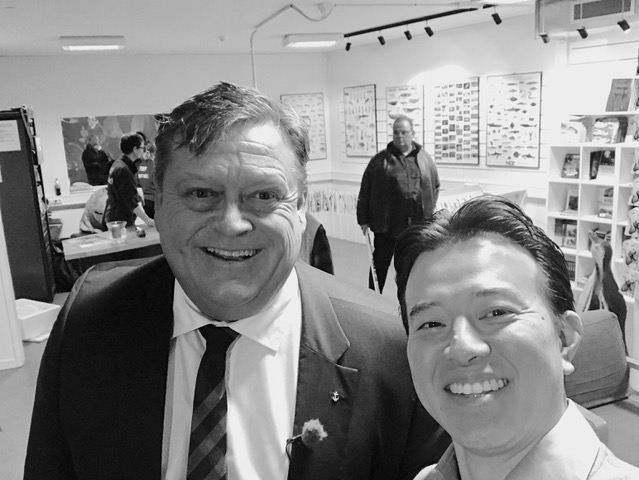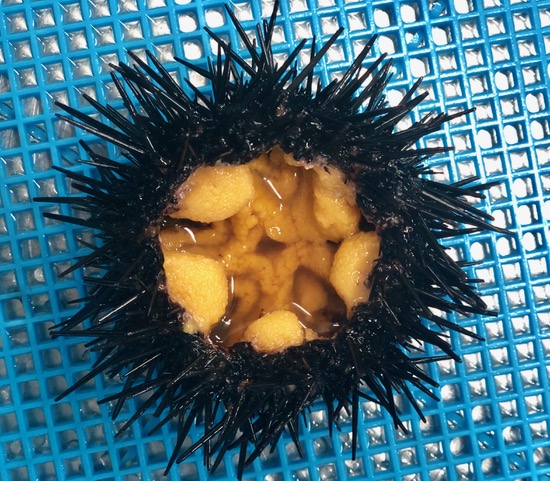Urchinomics: The Economics of Restorative Aquaculture
Urchinomics is apioneering aquaculture venture that aims to turn ecologically destructive sea urchins into high valued seafood products. The Urchinomics Methodology helps restore kelp forests, which in turn supports greater marine biomass, biodiversity, and capacity to sequester atmospheric CO2, all while creating meaningful, full time employment in rural, coastal communities in Europe and around the world.
a) 
 b)
b)
Figure 1. (a) Brian Takeda with the Norwegian Fisheries Minister, Harald Nesvik; (b) Brian Takeda with CFlow biologist, Frida Thyri Segafredo
Kelp forest destruction
Many of Europe’s coastal habitats, and the world ́s oceans in general, have been overfished without much thought to the overall consequence to the wider ecosystem. The overfishing of higher trophic, predatory species like lobsters, crabs and cod from the world´s oceans has, in some cases, unleashed a population explosion of voracious sea urchins, a group of spiny invertebrates that has decimated some of the world´s most productive kelp forests.
Urchinomics’ mission is to help reverse this trend by targeting and removing the urchins from the desert-like barrens, placing them in specially designed holding systems, and feeding them a naturally derived formulated feed. The Urchinomics systems results in the urchins producing plump, golden, flavor and umami-rich roe in less than 3 months. By enhancing the roe of these destructive sea urchins, we change these creatures from being an ecological and social problem into a commercially valuable opportunity. They effectively put a value on the empty, overgrazing sea urchins and create an incentive to remove them from the sea for further value adding. The roe can then be marketed to discerning, high end seafood lovers around the world. Likewise, by removing the sea urchins from the barren sea bed, it allows the kelp forests an opportunity to recover and once again become the habitat and food source for other living organisms from invertebrates to fish and mammals; thus, restoring the oceans natural ecosystem.
Turning an ecological and social problem into an economic opportunity
The name Urchinomics is derived from “Urchin” + “Economics”. The business model is based on channeling the ever-growing global demand for sea urchin roe and matching it with the growing supply of overgrazing sea urchins that are destroying vital ecosystems.
Urchinomics has built aquaculture technology through a broad spectrum of stakeholders including non-profit organisations, fishers, scientists, businesses and universities. Much like Urchinomics, these different stakeholders have a shared mission to restore kelp forests, also known as the ‘rainforests of the sea’. By removing these urchins from the ocean floor, they contribute to kelp forest restoration. The kelp forests in turn increase the biomass and biodiversity of marine life in coastal ecosystems, help sequester CO2dissolved in sea water and reduce the local effects of ocean acidification.
Urchinomics works closely with scientific partners like Nofima, one of the largest institutes for applied research within the fields of fisheries, aquaculture and food research in Europe and theNorwegian Institute for Water Research (NIVA), Norway’s leading institute for fundamental and applied research on marine and freshwaters.Together withfunding partners like Innovation Norway and the Research Council and commercial partners like Mitsubishi (Japan), Norway King Crab and Cflow, Urchinomics is establishing a category defining system and business model.
Moreover, Urchinomics continually seeks to work with other leading ecologists, biologists and R+D projects to further their understanding of urchin barrens and aquaculture in both Europe, and globally. Most recently, in February 2019, Urchinomics partnered with the leading US based conservancy organization, The Nature Conservancy (TNC), in a trial based out of University of California, Davis’s, Bodega Bay Marine Laboratory, where they will ranch kelp forest overgrazing urchins and turn them into delicious sea urchin roe or “uni’ for foodies around the world.
This restorative and innovative business model combined with a deep understanding of ecology/biology technology and market intelligence are the driving forces which are helping to propel Urchinomics as a new generation aquaculture venture for Blue Growth.

Figure 2. Ranched Purple urchins from the barrens in Aomori, Japan (20% yield in 10 weeks).
Web references:
https://www.urchinomics.com/our-news
https://noyocenter.org/help-the-kelp/
Authors:
Denise MacDonald +1(604) 319 0244 and Rolf Skala +1 (778) 386 5660

